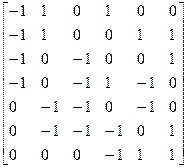
- Автоматизация
- Антропология
- Археология
- Архитектура
- Биология
- Ботаника
- Бухгалтерия
- Военная наука
- Генетика
- География
- Геология
- Демография
- Деревообработка
- Журналистика
- Зоология
- Изобретательство
- Информатика
- Искусство
- История
- Кинематография
- Компьютеризация
- Косметика
- Кулинария
- Культура
- Лексикология
- Лингвистика
- Литература
- Логика
- Маркетинг
- Математика
- Материаловедение
- Медицина
- Менеджмент
- Металлургия
- Метрология
- Механика
- Музыка
- Науковедение
- Образование
- Охрана Труда
- Педагогика
- Полиграфия
- Политология
- Право
- Предпринимательство
- Приборостроение
- Программирование
- Производство
- Промышленность
- Психология
- Радиосвязь
- Религия
- Риторика
- Социология
- Спорт
- Стандартизация
- Статистика
- Строительство
- Технологии
- Торговля
- Транспорт
- Фармакология
- Физика
- Физиология
- Философия
- Финансы
- Химия
- Хозяйство
- Черчение
- Экология
- Экономика
- Электроника
- Электротехника
- Энергетика
The loop matrix
2.2.2 The loop matrix
Topological matrixes can be compiled for circuit loops too.
 =
=  (2.4)
(2.4)
where,  are elements of the matrix
are elements of the matrix  .
.  =1 if the branch
=1 if the branch  is incident to the loop
is incident to the loop  and coincides with the direction of loop path-tracing;
and coincides with the direction of loop path-tracing;  =-1 if the branch
=-1 if the branch  is incident to the loop
is incident to the loop  and opposite to the direction of loop path tracing;
and opposite to the direction of loop path tracing;  =0 if the branch
=0 if the branch  is not incident to the loop
is not incident to the loop  . The loop matrix
. The loop matrix  corresponding to the directed graph with “
corresponding to the directed graph with “  ” loops and “
” loops and “  ” branches, is the name for the matrix
” branches, is the name for the matrix 

 . For instance, for the directed graph in Fig. 2.3,c we will get the matrix (2.5) when loop path-tracing is clockwise. Here, the branch of the current source
. For instance, for the directed graph in Fig. 2.3,c we will get the matrix (2.5) when loop path-tracing is clockwise. Here, the branch of the current source  is not used in the matrix because such a branch does not form a separate loop as mentioned above.
is not used in the matrix because such a branch does not form a separate loop as mentioned above.
It’s obvious that the parts of loops not used in the matrix (2.5) are linearly dependent. A loop, that includes at least one branch not being part of any other loops, is linearly independent.






 branches
branches
 =
= 

loops
For the planar circuits it’s easy to define the number of independent loops if we take these loops as meshes of the graph grid or “windows”. So for the graph in Fig.2.3,c the loops will be the following: 

 Then we get the submatrix
Then we get the submatrix  from the matrix
from the matrix  .
.






 =
= 
 (2.6)
(2.6)
The matrix  is called the matrix of main loops.
is called the matrix of main loops.
For nonplanar circuits, it is difficult to define the number of dependent loops from the number of “windows” in the graph. In this case, the T graph tree is used. A loop is formed by the connection of any chord to a tree. This loop is called the main loop. The direction of main loop path-tracing is taken as the chord direction. Thus, the number of main loops is equal to the number of chords of the selected graph tree. It is evident that it is equal to  . So, main loops for the tree in Fig. 2.3,b are formed by the chords: chord
. So, main loops for the tree in Fig. 2.3,b are formed by the chords: chord  loop
loop  chord
chord  loop
loop  chord
chord  loop
loop  Having arranged the edges in the lower columns, we get the matrix of main loops
Having arranged the edges in the lower columns, we get the matrix of main loops  for the graph with the tree in Fig. 2.3,b
for the graph with the tree in Fig. 2.3,b
Tree chords


 =
= 
 (2.7)
(2.7)
As seen from (2.7), any matrix  can be divided in the following way:
can be divided in the following way:
 =
=  (2.8)
(2.8)
where matrix  corresponds to the edges
corresponds to the edges
 edges
edges
 =
=  (2.9)
(2.9)

chords
Matrix 1 is a unit matrix and corresponds to the chords
 edges
edges
1=  (2.10)
(2.10)

chords
So, because the unit matrix is present in the matrix  , we can say that the lines of the matrix
, we can say that the lines of the matrix  are linearly independent.
are linearly independent.
|
|
|
© helpiks.su При использовании или копировании материалов прямая ссылка на сайт обязательна.
|